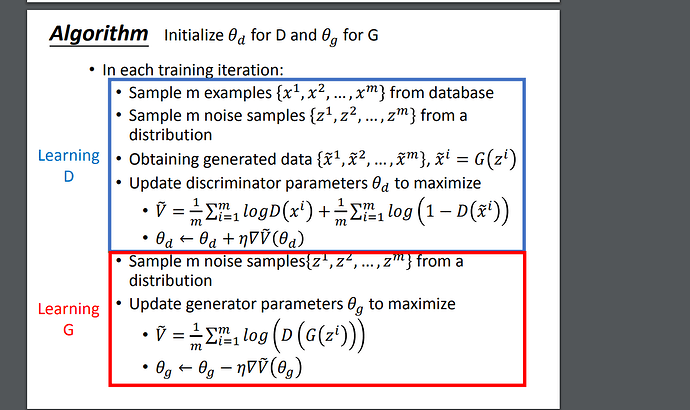i start to learn GAN, and try to write a code. but after 10000 step, it doesn’t work well.
i wanna know what goes wrong, and i think the the transform of uint to float type may be have a influence of accurate.
and loss function from this:
import torch
import numpy as np
import torch.nn as nn
import torchvision
import torchvision.datasets as dsets
import torchvision.transforms as transforms
import matplotlib.pyplot as plt
batch_size = 1
LR_G = 0.00001
LR_D = 0.00001
train_dataset = dsets.MNIST(root='../../data_sets/mnist', # 选择数据的根目录
train=True, # 选择训练集
transform=transforms.ToTensor(), # 转换成tensor变量
download=False) # 不从网络上download图片
# plot one example
""" python
print("e")
print(train_dataset.train_data[0].numpy())
plt.imshow(train_dataset.train_data[0].numpy(), cmap='gray')
plt.show()
"""
def paint(output):
output = output.detach().numpy()
output = output + 1
output = output / 2
output = output * 255
output.shape = -1, 28
plt.imshow(output, cmap='gray')
plt.show()
class View(nn.Module):
def __init__(self, size):
super(View, self).__init__()
self.size = size
def forward(self, x):
x = x.view(self.size)
return x
G = nn.Sequential(
nn.Linear(100, 7 * 7 * batch_size), # 线性层
nn.ReLU(),
View((batch_size, 1, 7, 7)), # 类似于reshape
nn.Upsample(size=14), # 上采样层 使size 改变
nn.Conv2d(in_channels=1, out_channels=12, kernel_size=5, padding=2),
nn.ReLU(),
nn.Upsample(28),
nn.Conv2d(in_channels=12, out_channels=32, kernel_size=5, padding=2),
nn.ReLU(),
nn.Conv2d(in_channels=32, out_channels=1, kernel_size=5, padding=2),
nn.Tanh()
)
# input shape [1,1,28,28]
# outpout shape[1,1]
D = nn.Sequential(
nn.Conv2d(in_channels=1, out_channels=12, kernel_size=5, padding=2),
nn.ReLU(),
nn.Conv2d(in_channels=12, out_channels=32, kernel_size=5, padding=2),
nn.ReLU(),
nn.Conv2d(in_channels=32, out_channels=64, kernel_size=5, padding=2),
nn.ReLU(),
nn.Conv2d(in_channels=64, out_channels=128, kernel_size=5, padding=2),
nn.ReLU(),
View((batch_size, 128 * 28 * 28)),
nn.Linear(128 * 28 * 28, 1),
nn.Sigmoid()
)
if torch.cuda.is_available():
D = D.cuda()
G = G.cuda()
opt_D = torch.optim.Adam(D.parameters(), lr=LR_D)
opt_G = torch.optim.Adam(G.parameters(), lr=LR_G)
def get(x):
x = x.unsqueeze(0)
x = x.unsqueeze(0)
x = x.float()
x = x / 255
x = x - 0.5
x = x * 2
x = x.float()
return x
for i in range(10000):
real = train_dataset.train_data[i%100]
real = get(real)
x = torch.randn(1, 100)
if torch.cuda.is_available():
real = real.cuda()
x = x.cuda()
output = G(x)
p0 = D(output)
p1 = D(real)
D_loss = - torch.mean(torch.log(p1) + torch.log(1 - p0))
opt_D.zero_grad()
D_loss.backward(retain_graph=True) # reusing computational graph
opt_D.step()
G_loss = torch.mean(torch.log(p0))
opt_G.zero_grad()
G_loss.backward()
opt_G.step()
print(i, ':', D_loss, " ", G_loss)
x = torch.randn(1, 100)
x = x.cuda()
output = G(x)
print(output)
#paint(output)
